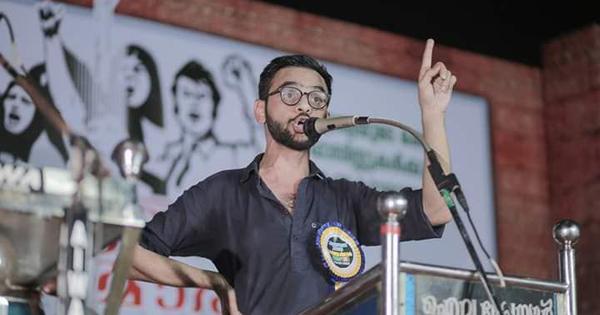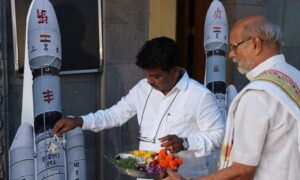
One of the most striking visuals to emerge from protests against the discriminatory Citizenship Amendment Act at New Delhi’s Jamia Millia Islamia campus and the Shaheen Bagh neighbourhood in 2019-2020 was the collective, performative reading of the Preamble of the Constitution of India. This was an entirely novel use of the Preamble. This tactic has become a powerful and widely resonant method of protest, and an assertion of rights by many marginalised groups across India.
Scholars have described this kind of protest tactic as an expression of constituent power. Constituent power is admittedly an abstract concept, but it essentially refers to a collective political will of the people when they assert that they have the capacity to take political decisions for themselves.
The Preamble is the declaration of this constituent power of Indians to become “a people”, a political unity who can determine their political future. The collective reading of the Constitution allowed participants to constitute themselves as “We, the People of India”.
It was particularly significant that this practice emerged from students who were not demanding any concessions or policy favouring them. By reading the Preamble in an assembly, they were actively constituting themselves as the people of India. This assertion carried added weight because Muslims have been denied a sense of belonging to the Indian nation, particularly since after the Partition.
The discourse of Indian nationhood has often been tied to specific texts and histories associated with “Indic” religions and identities, from which many minorities are implicitly excluded. By using the Constitution itself as their point of reference, these protestors were emphatically claiming that they, too, belong fully to the nation.
Devidas Jayant and Shakaib Akhtar, Dalit and a Muslim, read out the preamble at the #RepublicDay event organised by @ChalchitraAbhi & Naujawan Bharat Sabha at Kandhla town in Shamli district.
This area has been under massive police repression after the anti #NRC_CAA_NPR protests pic.twitter.com/mwv5ReHvKj— CCA (@CCAbhiyaan) January 28, 2020
In the winter of 2019 and 2020, two streams of protest – the movement against the Citizenship Amendment Act and the student struggles against fee hikes – mingled and reinforced each other. These movements, though distinct, together underscored the persistence of authoritarian responses to democratic dissent.
Students from various campuses in Delhi, and later from numerous universities across India, including private universities, spoke in defence of a particular idea of India. This was an idea of the nation not tied to a narrow cultural claim of primordial belonging, but rather rooted in the Constitution itself. It was, in other words, an affirmation of a constitutional culture.
Yet, these dissenters – particularly teachers and students – who protested against the narrowing of the Idea of India being were quickly branded “anti-national” by the Bharatiya Janata Party and its ideological partners, and soon after, by state agencies.
This was, of course, in continuation of the targeting of students from Delhi’s Jawaharlal Nehru University for asserting one of the basic tenets of constitutional culture, namely, that people accused of crimes have rights too. Recently, students at the Tata Institute for Social Sciences in Mumbai were targeted for the same reason.
Enactment of constitutional cultures
There has been a recent surge in scholars, civil society organisations, private institutions and individual citizens working toward popularising the Constitution of India. Which Constitution are we really invoking when we popularise it?
In the 2024 general election, the Constitution certainly animated public debate. But what was the artefact being invoked? Was it the illuminated manuscript of the Constitution – the one adorned with artwork that is often reproduced in exhibitions and commemorations? Or is it the red-and-black EBC lawyers’ pocket edition popularised by the opposition leader Rahul Gandhi?
When elements of the Constitution become popularised, they also enter the domain of popular culture. And in our times, political economists and scholars of cultural politics agree that anything that becomes popular is also quickly commodified. Once commodified, however, it risks losing the critical edge that it once carried.
Revering the artefact or the book, or even the black letter text itself is one thing, but it’s an entirely different thing to seriously consider the meanings ascribed to it, and the ways in which these meanings are mobilised by varied interests.
When we talk about constitutional consciousness among the people, there is often a debate about whom this consciousness should address. Is it only the downtrodden and the oppressed who must be mobilised to claim their rights? Should we not insist that the constitutional cultures also extend to the powerful, the oppressors, who must be called out and held accountable for living up to constitutional values? Both are, of course, important, but I would like to add a third dimension.
A huge, steel made map of INDIA has been installed at the protest site at Shaheen Bagh in Delhi with the message “We the people of India reject #CAA_NRC_NPR.”#शाह_पर_भारी_शहीनबाग pic.twitter.com/QmBFKUS2xB
— Sanjay Meena (@SanjayUkroond) January 21, 2020
Constitutional culture in the courts
What conception of the Constitution do our judges, particularly the constitutional courts, carry when they interpret it? Too often, their authority to interpret constitutional provisions begins to resemble a form of common law sovereignty, where whatever the judge pronounces becomes binding, whether or not it aligns with the spirit of the Constitution.
In India, and more so in recent years, we have had numerous judgments that have left civil society, activists and legal scholars deeply alarmed. In some cases, courts have upheld executive actions that many legal scholars have regarded as being unconstitutional. In others, when legislatures have overreached, citizens have appealed to the courts for protection, only to find either inaction or judicial endorsement of the illegality and arbitrariness they had challenged.
This highlights that constitutional consciousness cannot be limited to citizens alone; it must also be cultivated among the judiciary. For, as I have observed in student and teacher movements on university campuses, justice is not only about substantive outcomes – it also depends on procedural justice. Justice becomes inaccessible when procedure is subverted, and worse, it eludes those who need it most.
Many of us feel that if a wrong has been done, and the letter of law agrees that injustice has been committed, then justice ought to automatically follow. But when we go to courts, we realise that they do not function on moral reasoning alone. We cannot simply claim that something is morally or even legally wrong and expect that to be sufficient. Courts operate through procedures, rules, and technicalities. This often contains inconsistencies or loopholes.
Yesterday Akola had witnessed a huge Candle March Against CAA, NRC and NPR. Where the preamble of our constitution is also readed…..#WorldAgainstCAA_NRC_NPR#UnitedNotDivided pic.twitter.com/Bu8O2MkvBo
— Mr. Motlani (@SaleemMotlani) January 29, 2020
Procedural justice
On university campuses, we learned this lesson the hard way. It was not enough to say, “We are students, we are teachers, we are citizens of this country, we have been wronged, and we are not anti-nationals.” Such appeals rarely produced empathy. What works sometimes, is pointing to specific procedural violations.
Framing our demands to say that this rule has not been followed, this procedure has been flouted, betters the chances of securing something resembling justice.
In the prolonged bail hearings of Sharjeel Imam, Umar Khalid, Gulfisha Fatima, Meeran Haider and other young Muslims – who have been accused of conspiring to spark riots in Delhi amidst the citizenship protest because they dissented against a regime undermining constitutional values – things have though reached such a pass that gesturing to grand notions of justice can no longer obscure the fact that injustice in practice is produced by flouting of procedure.
For this reason, I want to argue that one of the constitutional values we need to popularise today is the value of procedural justice: holding the state accountable to its own laws, procedures, and rules. Even if this does not deliver the full promise of constitutional morality, it at least provides a toehold to the belief that we might see justice being served eventually.
Constitutional consciousness, then, is best understood as a disposition of ordinary citizens who agree to be governed by a written document. The Constitution must not be made “sacred” like a religious text that is scarcely understood, rarely practiced by those who ritually use it in their self-serving intonations.
India’s Constitution has evolved in response to challenging contingencies and profound disagreements in its political community but, and I cannot overemphasise it, all citizens – whether they agree with it or not – are bound to follow it. Dissent too has an important space in constitutional culture, especially through the right to association and assembly. The problem is that in practice the powerless are often compelled to follow rules that are not really the law, while the powerful enjoy impunity, arrogating to themselves unchecked authority.
This is why it is essential to insist both on procedural justice and on recognising the Constitution as a contingent document that the people of India aspire to live by.
Preamble being recited at the #CAA_NRCProtests in Bhubaneswar today. #CAA_NRC_Protests pic.twitter.com/cGQbosxSS2
— Priya Ranjan Sahu (@spriyaranjan1) January 30, 2020
Future of constitutional cultures
Much of the discussion in civil society and academia emphasises representation, intersectionality and the recovery of erased histories. These are all crucial. But what strikes me is how little we speak about the future. History matters deeply but if our engagement with history does not lead us toward a better future, then its emancipatory potential is lost.
Here I find something profoundly important in student and university politics. Students, even when burdened by inherited traumas such as that of communal violence, of gendered exclusions or of caste oppression, insist on talking about futures.
Students in elite institutions, even those coming from (relative) privilege, have taken up the causes of marginalised and oppressed groups, providing energy and leadership to many of the great movements in both colonial and post-colonial India.
Today, when India’s youth face staggering levels of unemployment, shrinking access to education, and the neoliberal hollowing out of public universities, it is all the more urgent to think in these terms. To stifle student politics and to exact a crushing price from students and intellectuals who care for humanity enough to risk everything, might prove to be a final blow to constitutional cultures in India.
Ghazala Jamil is an Assistant Professor at the Centre for the Study of Law and Governance, Jawaharlal Nehru University.
📰 Crime Today News is proudly sponsored by DRYFRUIT & CO – A Brand by eFabby Global LLC
Design & Developed by Yes Mom Hosting






